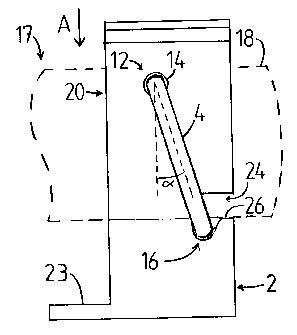Some of the information on this Web page has been provided by external sources. The Government of Canada is not responsible for the accuracy, reliability or currency of the information supplied by external sources. Users wishing to rely upon this information should consult directly with the source of the information. Content provided by external sources is not subject to official languages, privacy and accessibility requirements.
Any discrepancies in the text and image of the Claims and Abstract are due to differing posting times. Text of the Claims and Abstract are posted:
| (12) Patent: | (11) CA 2554220 |
|---|---|
| (54) English Title: | FUSE HOLDER |
| (54) French Title: | PORTE-FUSIBLE |
| Status: | Granted and Issued |
| (51) International Patent Classification (IPC): |
|
|---|---|
| (72) Inventors : |
|
| (73) Owners : |
|
| (71) Applicants : |
|
| (74) Agent: | GOWLING WLG (CANADA) LLP |
| (74) Associate agent: | |
| (45) Issued: | 2012-07-10 |
| (86) PCT Filing Date: | 2005-02-02 |
| (87) Open to Public Inspection: | 2005-08-18 |
| Examination requested: | 2009-12-14 |
| Availability of licence: | N/A |
| Dedicated to the Public: | N/A |
| (25) Language of filing: | English |
| Patent Cooperation Treaty (PCT): | Yes |
|---|---|
| (86) PCT Filing Number: | PCT/FI2005/000069 |
| (87) International Publication Number: | WO 2005076306 |
| (85) National Entry: | 2006-07-21 |
| (30) Application Priority Data: | ||||||
|---|---|---|---|---|---|---|
|
A fuse holder comprising a frame (2), spring means and limiter means (6), the
frame (2) comprising a first contact member (8) and a second contact member
(10) adapted to receive an end (18) of the fuse between them, the spring means
being adapted to press the contact members (8, 10) against the fuse end (18)
to achieve an electrically conductive connection between the contact members
(8, 10) and the fuse end (18), and the limiter means (6) being adapted to
define the largest possible depth of the fuse end (18) in the installation
direction between the first (8) and second (10) contact members. The spring
means comprise a substantially circular arch-formed ring spring (4) adapted to
also serve as the limiter means (6).
Porte-fusible composé d'un cadre (2), de moyens élastiques et de moyens de limitation (6), le cadre (2) comprenant un premier élément de contact (8) et un deuxième élément de contact (10) conçus pour recevoir une extrémité (18) du fusible entre lesdits éléments de contact, les moyens élastiques étant conçus pour exercer une pression sur les éléments de contact (8, 10) contre l'extrémité du fusible (18) afin de créer un raccordement électrique entre lesdits éléments de contact (8, 10) et l'extrémité du fusible (18), les moyens de limitation (6) étant conçus pour définir la profondeur la plus grande possible de l'extrémité du fusible (18) dans le sens de l'installation entre le premier (8) et le deuxième (10) élément de contact. Les moyens élastiques comprennent un ressort annulaire incurvé pratiquement circulaire (4) conçu également pour servir de moyens de limitation (6).
Note: Claims are shown in the official language in which they were submitted.
Note: Descriptions are shown in the official language in which they were submitted.

2024-08-01:As part of the Next Generation Patents (NGP) transition, the Canadian Patents Database (CPD) now contains a more detailed Event History, which replicates the Event Log of our new back-office solution.
Please note that "Inactive:" events refers to events no longer in use in our new back-office solution.
For a clearer understanding of the status of the application/patent presented on this page, the site Disclaimer , as well as the definitions for Patent , Event History , Maintenance Fee and Payment History should be consulted.
| Description | Date |
|---|---|
| Common Representative Appointed | 2019-10-30 |
| Common Representative Appointed | 2019-10-30 |
| Letter Sent | 2019-05-03 |
| Inactive: Multiple transfers | 2019-04-17 |
| Change of Address or Method of Correspondence Request Received | 2018-01-10 |
| Grant by Issuance | 2012-07-10 |
| Inactive: Cover page published | 2012-07-09 |
| Pre-grant | 2012-04-25 |
| Inactive: Final fee received | 2012-04-25 |
| Notice of Allowance is Issued | 2012-04-12 |
| Letter Sent | 2012-04-12 |
| Notice of Allowance is Issued | 2012-04-12 |
| Inactive: Approved for allowance (AFA) | 2012-04-02 |
| Amendment Received - Voluntary Amendment | 2011-08-22 |
| Inactive: S.30(2) Rules - Examiner requisition | 2011-02-24 |
| Letter Sent | 2010-01-21 |
| Request for Examination Requirements Determined Compliant | 2009-12-14 |
| All Requirements for Examination Determined Compliant | 2009-12-14 |
| Amendment Received - Voluntary Amendment | 2009-12-14 |
| Request for Examination Received | 2009-12-14 |
| Letter Sent | 2006-10-13 |
| Inactive: Correspondence - Transfer | 2006-09-28 |
| Inactive: Courtesy letter - Evidence | 2006-09-19 |
| Inactive: Cover page published | 2006-09-19 |
| Inactive: Notice - National entry - No RFE | 2006-09-15 |
| Inactive: Single transfer | 2006-09-08 |
| Application Received - PCT | 2006-08-30 |
| National Entry Requirements Determined Compliant | 2006-07-21 |
| Application Published (Open to Public Inspection) | 2005-08-18 |
There is no abandonment history.
The last payment was received on 2012-01-30
Note : If the full payment has not been received on or before the date indicated, a further fee may be required which may be one of the following
Please refer to the CIPO Patent Fees web page to see all current fee amounts.
Note: Records showing the ownership history in alphabetical order.
| Current Owners on Record |
|---|
| ABB SCHWEIZ AG |
| Past Owners on Record |
|---|
| HARRI MATTLAR |
| JUHO SALO |